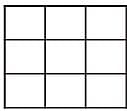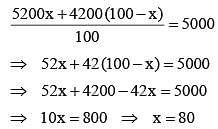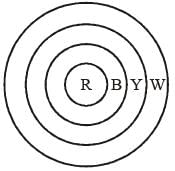Test: Arithmetic - 3 (2017-2016) - UPSC MCQ
20 Questions MCQ Test - Test: Arithmetic - 3 (2017-2016)
There are 4 horizontal and 4 vertical lines, parallel and equidistant to one another on a board. What is the maximum number of rectangles and squares that can be formed?
[2017]
There is a milk sample with 50% water in it. If 1/3rd of this milk is added to equal amount of pure milk, then water in the new mixture will fall down to
[2017]
| 1 Crore+ students have signed up on EduRev. Have you? Download the App |
There are thirteen 2-digit consecutive odd numbers. If 39 is the mean of the first five such numbers, then what is the mean of all the thirteen numbers?
[2017]
A clock strikes once at 1 o'clock, twice at 2 o'clock and thrice at 3 o'clock, and so on. If it takes 12 seconds to strike at 5 o'clock, what is the time taken by it to strike at 10 o'clock?
[2017]
In a city, 12% of households earn less than ₹ 30,000 per year, 6% households earn more than ₹ 2,00,000 per year, 22% households earn more than ₹ 1,00,000 per year and 990 households earn between ₹ 30,000 and ₹ 1,00,000 per year. How many households earn between ₹ 1,00,000 and ₹ 2,00,000 per year?
[2017]
A watch loses 2 minutes in every 24 hours. while another watch gains 2 minutes in every 24 hours. At a particular instant, the two watches showed an identical time. Which of the following statements is correct if 24-hour clock is followed?
[2017]
Suppose the average weight of 9 persons is 50 kg. The average weight of the first 5 persons is 45 kg, whereas the average weight of the last 5 persons is 55 kg, Then the weight of the 5th person will be
[2017]
Gopal bought a cell phone and sold it to Ram at 10% profit. Then Ram wanted to sell it back to Gopal at 10% loss. What will be Gopal's position if he agreed?
[2017]
There are three pillars, X, Y and Z of different heights. Three spiders A, B and C start to climb on these pillars simultaneously. In one chance. A climbs on X by 6cm but slips down 1 cm. B climbs on Y by 7 cm but slips down 3 cm. C climbs on Z by 6.5 cm but slips down 2 cm. If each of the requires 40 chances to reach the top of the pillars, what is the height of the shortest pillar?
[2017]
What is the total number of digits printed, if a book containing 150 pages is to be numebred from 1 to 150
[2017]
If there is a policy that 1/3rd of a population of a community has migrated every year from one place to some other place, what is the leftover population of that community after the sixth year, if there is no further growth in the population during this period?
[2017]
Two numbers X and Y are respectively 20% and 28% less than a third number Z. By what percentage is the number Y less than the number X?
[2016]
The monthly average salary paid to all the employees of a company was ₹ 5000. The monthly average salary paid to male and female employees was ₹ 5200 and ₹ 4200 respectively. Then the percentage of males employed in the company is:
[2016]
In a class, there are 18 very tall boys. If these constitute three-fourths of the boys and the total number of boys is two-thirds of the total number of students in the class, what is the number of girls in the class?
[2016]
Anita’s mathematics test had 70 problems carrying equal marks i.e., 10 arithmetic, 30 algebra and 30 geometry. Although she answered 70% of the arithmetic, 40% of the algebra and 60% of the geometry problems correctly, she did not pass the test because she got less than 60% marks. The number of more questions she would have to answer correctly to earn a 60% passing marks is:
[2016]
In aid of charity, every student in a class contributes as many rupees as the number of students in that class. With the additional contribution of ₹ 2 by one student only, the total collection is ₹ 443. Then how many students are there in the class?
[2016]
30g of sugar was mixed in 180 ml water in a vessel A, 40 g of sugar Was mixed in 280 ml of water in vessel B and 20 g of sugar was mixed in 100 ml of water in vessel C. The solution in vessel B is :
[2016]
A class starts at 11:00 am and lasts till 2:27 pm. Four periods of equal duration are held during this interval. After every period, a rest of 5 minutes is given to the students. The exact duration of each period is:
[2016]
A person allows 10% discount for cash payment from the marked price of a toy and still he makes a 10% gain. What is the cost price of the toy which is marked ₹ 770?
[2016]
A round archery target of diameter 1 m is marked with four scoring regions from the centre outwards as red, blue, yellow and white. The radius of the red band is 0.20 m. The width of all the remaining bands is equal. If archers throw arrows towards the target, what is the probability, that the arrows fall in the red region of the archery target?
[2016]



 .
.


































